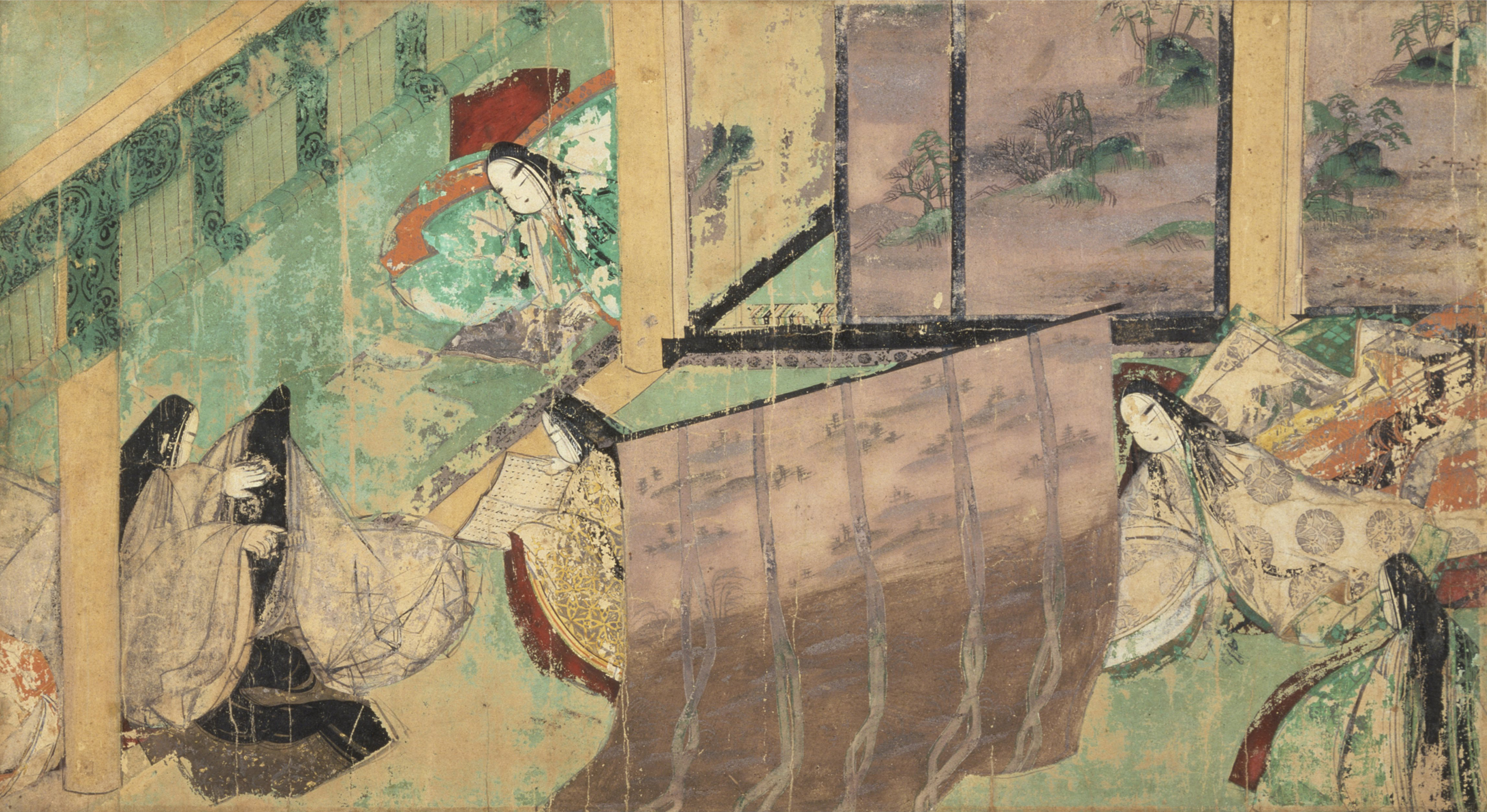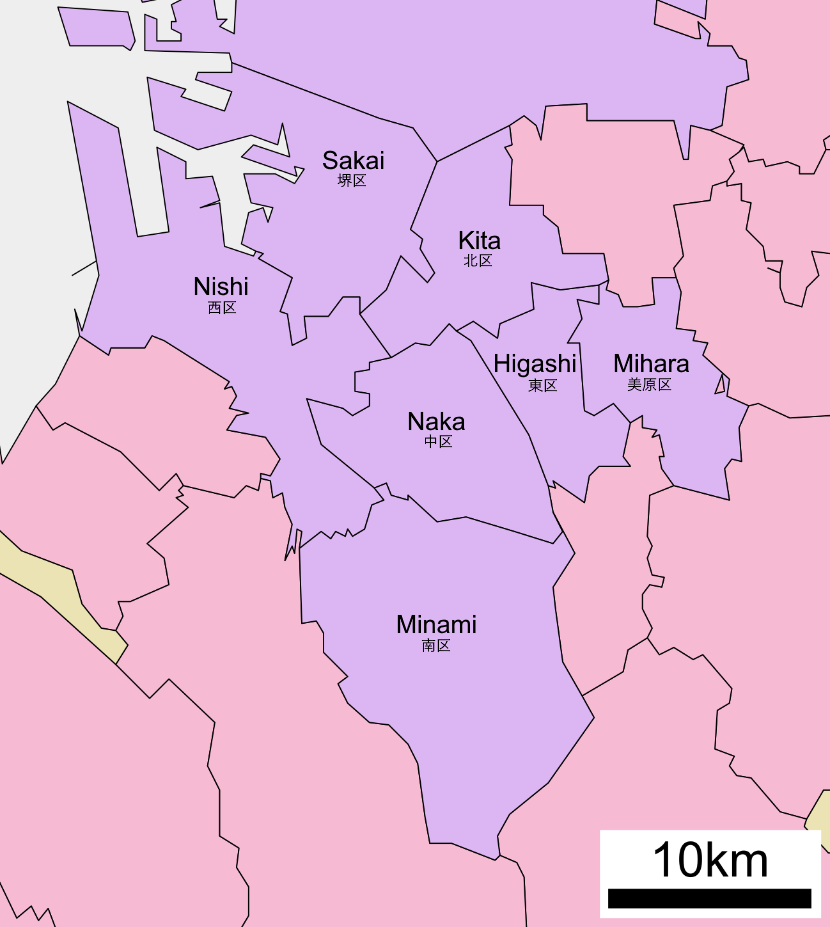|
Tosa School
of Japanese painting was founded in the early Muromachi period (14th–15th centuries),,p.988 and was devoted to ''yamato-e'', paintings specializing in subject matter and techniques derived from ancient Japanese art, as opposed to schools influenced by Chinese art, notably the Kanō school (狩野派). Tosa school paintings are characterised by "areas of flat opaque colour enclosed by simple outlines, where drawing is precise and conventional", with many narrative subjects from Japanese literature and history. However, by the 17th century both Tosa and Kanō artists broadened their range, and the distinction between these and other schools became less clear. The origins of this school of painting can be traced to (fl. first half 15th century), ''Encyclopedia of World Art"", pp. 1032–3 who first used the professional name of Tosa, though unverified claims to earlier origins were made later by Mitsunobu (1434?–?1525) who formally founded the school. Mitsunobu served as the o ... [...More Info...] [...Related Items...] OR: [Wikipedia] [Google] [Baidu] |
Kiyomizudera Engi Emaki - Scroll2 Pic11
is a Buddhist temple located in eastern Kyoto, Japan. The temple is part of the Historic Monuments of Ancient Kyoto (Kyoto, Uji and Otsu Cities) UNESCO World Heritage site. History Kiyomizu-dera was founded in the early Heian period. By 778, it was owned by the Buddhist Kita-Hosso sect under Enchin Shonin. He was a priest from Nara (capital of Japan from 710 to 784), who received a vision to construct the temple next to the Otowa spring. In 798, the ''shogun'' Sakanoue Tamuramaro, improved the site by including a large hall that was reassembled from the palace of Emperor Kammu (r. 781–806). The emperor left Nara due to the strong influence that the Buddhist monasteries had on the government there. During this period there was a strong rivalry between the Kofuku-ji and the Kiyomizu-dera temples and both had strong influences around the region. The temple's present buildings were constructed in 1633, ordered built by Tokugawa Iemitsu. There is not a single nail used in t ... [...More Info...] [...Related Items...] OR: [Wikipedia] [Google] [Baidu] |
Emaki
or is an illustrated horizontal narration system of painted handscrolls that dates back to Nara-period (710–794 CE) Japan. Initially copying their much older Chinese counterparts in style, during the succeeding Heian (794–1185) and Kamakura periods (1185–1333), Japanese developed their own distinct style. The term therefore refers only to Japanese painted narrative scrolls. As in the Chinese and Korean scrolls, combine calligraphy and illustrations and are painted, drawn or stamped on long rolls of paper or silk sometimes measuring several metres. The reader unwinds each scroll little by little, revealing the story as seen fit. are therefore a narrative genre similar to the book, developing romantic or epic stories, or illustrating religious texts and legends. Fully anchored in the style, these Japanese works are above all an everyday art, centered on the human being and the sensations conveyed by the artist. Although the very first 8th-century were copies of C ... [...More Info...] [...Related Items...] OR: [Wikipedia] [Google] [Baidu] |
Ukiyo-e
Ukiyo-e is a genre of Japanese art which flourished from the 17th through 19th centuries. Its artists produced woodblock prints and paintings of such subjects as female beauties; kabuki actors and sumo wrestlers; scenes from history and folk tales; travel scenes and landscapes; flora and fauna; and erotica. The term translates as "picture of the floating world". In 1603, the city of Edo (Tokyo) became the seat of the ruling Tokugawa shogunate. The '' chōnin'' class (merchants, craftsmen and workers), positioned at the bottom of the social order, benefited the most from the city's rapid economic growth, and began to indulge in and patronise the entertainment of kabuki theatre, geisha, and courtesans of the pleasure districts; the term ("floating world") came to describe this hedonistic lifestyle. Printed or painted ukiyo-e works were popular with the ''chōnin'' class, who had become wealthy enough to afford to decorate their homes with them. The earliest ukiyo-e work ... [...More Info...] [...Related Items...] OR: [Wikipedia] [Google] [Baidu] |
Sumiyoshi Jokei , Shinto architectural style
{{disambiguation ...
Sumiyoshi (written: 住吉) may refer to: *Sumiyoshi (name) *, Shinto shrine in Osaka, Japan *, ward of Osaka, Japan *, prefectural park in Osaka, Japan *, multiple train stations in Japan *Sumiyoshi sanjin, generic name for three Shinto gods of the sea *Sumiyoshi-zukuri is an ancient Japanese Shinto shrine architectural style which takes its name from Sumiyoshi Taisha's ''honden'' in Ōsaka. As in the case of the '' taisha-zukuri'' and ''shinmei-zukuri'' styles, its birth predates the arrival of Buddhism in Jap ... [...More Info...] [...Related Items...] OR: [Wikipedia] [Google] [Baidu] |
Quail
Quail is a collective name for several genera of mid-sized birds generally placed in the order Galliformes. The collective noun for a group of quail is a flock, covey, or bevy. Old World quail are placed in the family Phasianidae, and New World quail are placed in the family Odontophoridae. The species of buttonquail are named for their superficial resemblance to quail, and form the family Turnicidae in the order Charadriiformes. The king quail, an Old World quail, often is sold in the pet trade, and within this trade is commonly, though mistakenly, referred to as a "button quail". Many of the common larger species are farm-raised for table food or egg consumption, and are hunted on game farms or in the wild, where they may be released to supplement the wild population, or extend into areas outside their natural range. In 2007, 40 million quail were produced in the U.S. New World *Genus '' Callipepla'' **Scaled quail, (commonly called blue quail) ''Callipepla squamat ... [...More Info...] [...Related Items...] OR: [Wikipedia] [Google] [Baidu] |
Emperor Go-Mizunoo
was the 108th Emperor of Japan, according to the traditional order of succession. Go-Mizunoo's reign spanned the years from 1611 through 1629, and was the first emperor to reign entirely during the Edo period. This 17th-century sovereign was named after the 9th-century Emperor Seiwa, sometimes posthumously referred to as because this is the location of his tomb, and translates as "later", and thus, he could be called the "Later Emperor Mizunoo". The Japanese word ''go'' has also been translated to mean the "second one", and in some older sources, this emperor may be identified as "Mizunoo II". Genealogy Before Go-Mizunoo's accession to the Chrysanthemum Throne, his personal name (his '' imina'') was or Masahito.He was the third son of Emperor Go-Yōzei and his consort, Konoe Sakiko.Price Kotohito had 11 full siblings (7 sisters and 4 brothers). He resided together with concubines in the Dairi of the Heian Palace. He had 33 children with his empress consort and 6 concub ... [...More Info...] [...Related Items...] OR: [Wikipedia] [Google] [Baidu] |
Tosa Mitsuoki
was a Japanese painter. Tosa Mitsuoki succeeded his father, Tosa Mitsunori (1583–1638), as head of the Tosa school and brought the Tosa school to Kyoto after around 50 years in Sakai. When the school was settled in Sakai, Mitsunori painted for townsmen. The school was not as prolific as it once was when Mitsunobu, who painted many fine scrolls (1434–1525) ran the school. Mitsuoki moved out of Sakai with his father, in 1634 and into the city of Kyoto. There, he hoped to revive the Tosa school to gain status back into the Kyoto court. Around the time of 1654 he gained a position as court painter (edokoro azukari) that had for many years traditionally been held by the Tosa family, but was in possession of the Kano school since the late Muromachi period (1338–1573). Restoring the Tosa School In 1634, Mitsuoki relocataed from Sakai, Osaka prefecture to the capitol at the behest of Emperor Go-Mizunoo. Mitsunori began painting ceremonial fans sensu for the court. In 1654, Mits ... [...More Info...] [...Related Items...] OR: [Wikipedia] [Google] [Baidu] |
Tosa Mitsunori
Tosa Mitsunori (土佐光則, January 16, 1583 to March 1, 1638) was an illustrator from the Tosa school of painting during the Azuchi–Momoyama period and the early Edo period. He was a son of Tosa Mitsuyoshi and the father of Tosa Mitsuoki. Although having moved to Sakai in his youth, he sometimes presented painted fanss to the Sentō Imperial Palace, but he did not receive a position at the court. About the age of 52, in his later years, he returned to Kyoto Kyoto (; Japanese: , ''Kyōto'' ), officially , is the capital city of Kyoto Prefecture in Japan. Located in the Kansai region on the island of Honshu, Kyoto forms a part of the Keihanshin metropolitan area along with Osaka and Kobe. , the ... with his eldest son, Mitsuoki. Many small works with gold backgrounds using variegated paints kept up the tradition of the Tosa school and showed much skill in their delicacy of depiction and the combinations of colours. Among the few surviving works of Mitsunori is a s ... [...More Info...] [...Related Items...] OR: [Wikipedia] [Google] [Baidu] |
Sakai, Osaka
is a city located in Osaka Prefecture, Japan. It has been one of the largest and most important seaports of Japan since the medieval era. Sakai is known for its keyhole-shaped burial mounds, or kofun, which date from the fifth century and include Mozu Tombs, Daisen Kofun, the largest grave in the world by area. Once known for Katana, swords, Sakai is now famous for the quality of its Japanese kitchen knife, cutlery. , the city had an estimated population of 819,965, making it the fourteenth most populous city in Japan (excluding Tokyo). Geography Sakai is located in southern Osaka Prefecture, on the edge of Osaka Bay and directly south of the city of Osaka. Neighboring municipalities Osaka Prefecture *Osaka *Matsubara, Osaka, Matsubara *Habikino, Osaka, Habikino *Ōsakasayama, Osaka, Ōsakasayama *Kawachinagano, Osaka, Kawachinagano *Izumi, Osaka, Izumi *Takaishi, Osaka, Takaishi Climate Sakai has a Humid subtropical climate (Köppen ''Cfa'') characterized by warm summers and ... [...More Info...] [...Related Items...] OR: [Wikipedia] [Google] [Baidu] |

.jpg)




